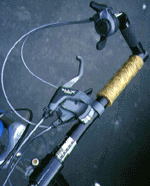|
Shimano Rapid Rise Rear Derailleur
& Remote Bar-End Thumb Shifter
Shimano loves to invent new bike products. From V- to hub roller brakes, SPD pedals to hollow-forged cranks, this Japan/US brain trust is forever introducing new components for your drivetrain. Whether we need these oft- pricey upgrades notwithstanding, the S-company is always showing us something on which to spend our rubles. Early last season the engineers upped the ante yet another notch with two more items you never knew you needed but may soon be unable to live without; the rapid rise derailleur and remote bar end shifter. Designed exclusively for the pricey XTR level of racing components, these two tidbits of trickery should prove superfluous for many a novice and indispensable for anyone wearing a racing number. I had a chance to abuse these gray-anodized gadgets recently with none other than the man himself; Shimano's Steve Boehmke. Dragging my sorry ass around a "suburban off-road circuit" in Fullerton, Ca. - Mr. Boehmke and I took a couple XTR-equipped hardtails over hill and dale to test the mettle of these current innovations in rear shifting. After tackling granny gear climbs, sweeping drops and undulating terrain, I came away with a solid appreciation for the help these little wonders provide.
Okay, so what are the goods? First is the remote bar-end shifter. Mounted on the tip of your right bar end, this mini shifter guides cables to your existing '98 XTR shifter pod, allowing you to shift whilst on the climb or simply hanging out on the bar ends. If you're using '96 or '97 shifters, a $100 upgrade will bring you up to speed. Used with great success during the '97 racing season, the remote shifter is most useful when honkin' up a hill or haulin' over rolling terrain where you're constantly shifting. For some this may seem excessive and, to be honest, I didn't use them that much on my 11 mile jaunt. But I wasn't racing either, and suspect that over the course of a 2-hour cross-country race they'd be your best friend next to a Gu pouch. This brings up a point — this shifter is designed for serious XC riding. If you're a downhill racer you don't even have bar ends, so fuggitabudit. If you don't stress over missed shifts in your normal riding, you can also probably pass on this one. But if you have $20 and 55 grams to spare and love gadgets, pick up the phone.
The Derailleur
The upside of the reverse spring, or rapid rise, derailleur is reduced effort and more accurate shifting. As Boehmke puts it: "Instead of pushing the chain up against a wall of steel for a bigger cog, you let the spring do it. You're now pushing the chain down against air to a smaller cog for harder gears - it's easier." Also, by letting the indexed spring movement put you in lower gears, you'll never blow a shift on the climb and can shift under the heaviest pedaling load. Other features on the rapid rise include a built in (and removable) cable roller guide and larger jockey wheels. The downside, however, is significant. Because you now have indexed downshifting, you can't grab multiple gears as you hit an unexpected hill - you have to clickity-click up the cogset until you reach the right gear. "We're working on that one" Boehmke promises. Meanwhile you can buy either version of the rear mech in '98 as Shimano gauges consumer acceptance. You'll also pay a bit in the weight arena, with a total weight of 227 grams - a few grams heavier than the original model. Overall the benefits seem to match or outweigh the costs for these new components, so you be the judge. The rapid rise system looks like a winner, and will hopefully find its way down to the XT and LX level of components soon. The jury's out on remote shifting, but if it wins races it'll be around on XTR groups for the time being. Look for these new products at a bike shop near you.
— Ari Cheren, Mountain Zone Contributor
| |||

